Everest Base Camp Trek in 14 Days
One might question the feasibility of experiencing the Everest Base Camp Trek in just 14 days, doubting the ability to fully take in such a monumental journey. However, this condensed itinerary is designed to provide a comprehensive and awe-inspiring adventure, allowing trekkers to witness the grandeur of the Himalayas in a focused timeframe.
As adventurers set foot on the iconic trails leading to the base camp, they will find themselves enveloped in a world where nature’s magnificence meets human resilience. The allure of this epic trek lies not only in conquering heights but in discovering one’s own limits and forging unforgettable memories amidst the world’s highest peaks.
Key Points
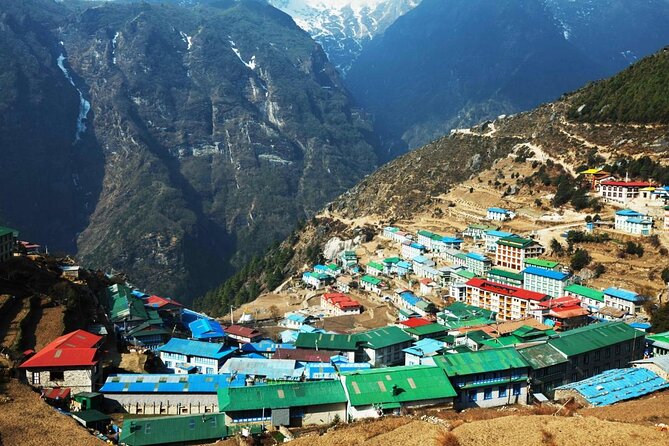
- Feasible completion of Everest Base Camp trek in 14 days
- Immersive adventure showcasing Himalayan grandeur
- Unforgettable journey witnessing world’s highest peaks
- Focused timeframe for a monumental trekking experience
Arrival in Kathmandu
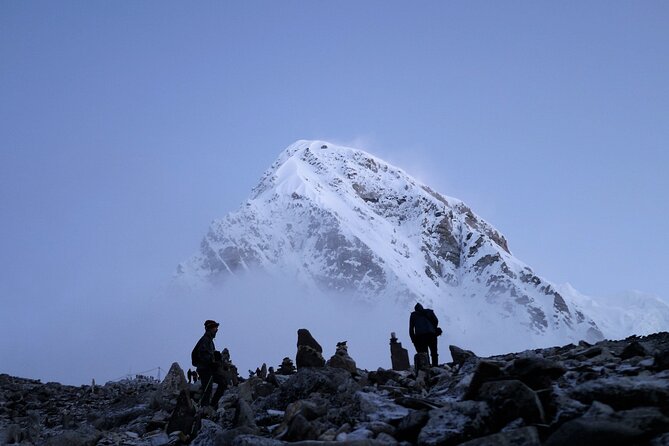
Upon arriving in Kathmandu for the Everest Base Camp trek, travelers will be greeted by the bustling energy of the city’s vibrant streets and the promise of an unforgettable adventure ahead.
Before embarking on the trek, visitors can enjoy cultural exploration by visiting ancient temples like Swayambhunath and Boudhanath, where they can witness monks chanting and spinning prayer wheels.
The local cuisine in Kathmandu offers a delightful array of flavors, from momos (dumplings) to dal bhat (lentils and rice), providing a taste of traditional Nepalese dishes.
Travelers can also explore the colorful markets, where they can sample street food like samosas and enjoy the hustle and bustle of the city’s lively atmosphere.
Fly to Lukla (2,800m)
After a refreshing night’s rest in Kathmandu, travelers eagerly prepare to embark on their thrilling journey as they fly to Lukla, situated at an altitude of 2,800 meters.
The Lukla airport, known for its challenging runway carved into the mountainside, offers a breathtaking experience with panoramic mountain views. As the small aircraft navigates through the Himalayan peaks, passengers can catch glimpses of the majestic terrain that awaits them.
The short but exhilarating flight sets the tone for the adventure ahead, providing a taste of the awe-inspiring landscapes that will accompany trekkers throughout their Everest Base Camp journey. The anticipation builds as the aircraft descends towards Lukla, marking the official start of this epic trekking experience.
Trek to Phakding (2,652m)
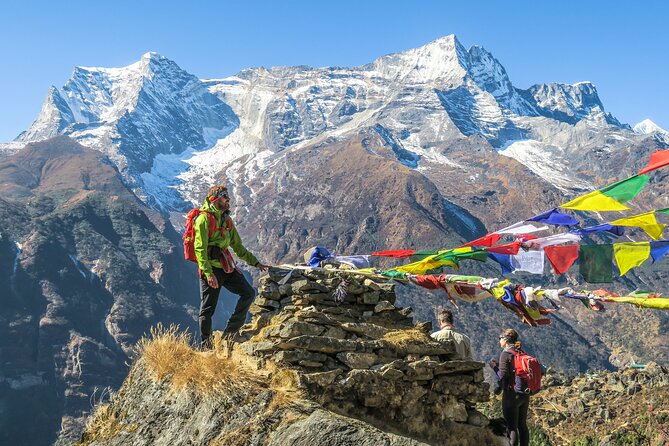
Embarking on the trek to Phakding at an elevation of 2,652 meters, trekkers set out from Lukla, seeing the picturesque landscapes of the Everest region. The journey to Phakding offers trekkers a taste of what’s to come, with stunning mountain views and glimpses of local culture along the way.
Markdown List:
-
Rugged Terrain: The trail to Phakding weaves through rugged terrain, providing trekkers with a thrilling and challenging experience.
-
Sherpa Villages: Along the route, trekkers pass through charming Sherpa villages, giving them a glimpse into the unique local culture and way of life.
-
River Crossings: Crossing several suspension bridges over the Dudh Koshi River adds an element of adventure to the trek, enhancing the overall experience.
Namche Bazaar (3,440m)
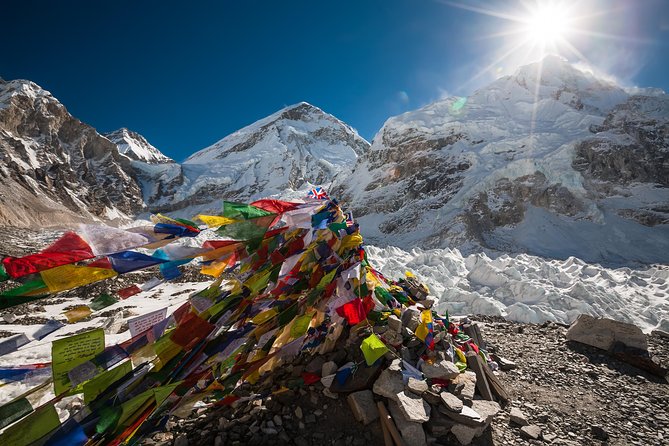
Weaving through rugged terrain and picturesque landscapes, trekkers heading towards Namche Bazaar at an elevation of 3,440 meters encounter a vibrant hub nestled in the heart of the Everest region. Namche Bazaar offers a rich cultural experience, allowing visitors to enjoy the local way of life. Exploring the narrow alleys lined with colorful prayer flags, one can explore the local cuisine, savoring traditional Sherpa dishes like Dal Bhat and Sherpa stew. The town’s bustling marketplace provides an excellent opportunity for culture, where trekkers can interact with locals, browse handmade crafts, and witness the unique blend of Sherpa and Tibetan cultures. Below is a table highlighting the significance of local cuisine and culture in Namche Bazaar:
| Local Cuisine | Cultural Immersion |
|---|---|
| Dal Bhat | Interacting with locals |
| Sherpa stew | Browsing handmade crafts |
| Traditional Sherpa dishes | Witnessing Sherpa and Tibetan cultures |
Acclimatization in Namche
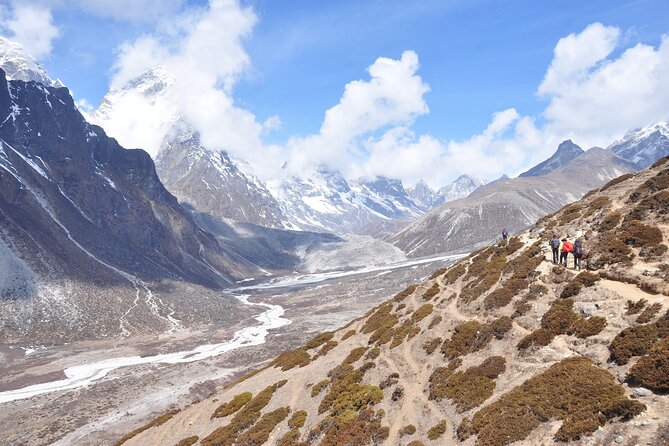
Acclimatization in Namche involves gradually adjusting to the altitude to prevent altitude sickness and ensure a safe and enjoyable trekking experience.
-
Stay Hydrated: Drinking plenty of water helps combat the effects of altitude and reduces the risk of altitude sickness.
-
Take it Slow: Engage in short hikes around Namche to aid in acclimatization and allow your body to adjust to the altitude.
-
Proper Nutrition: Eating light, high-carb meals and avoiding alcohol aids in acclimatization, providing the necessary energy for your body to adapt to higher altitudes.
These acclimatization techniques are essential for a successful trek to Everest Base Camp, ensuring that trekkers can safely enjoy the breathtaking views without being affected by altitude sickness.
Tengboche (3,867m)
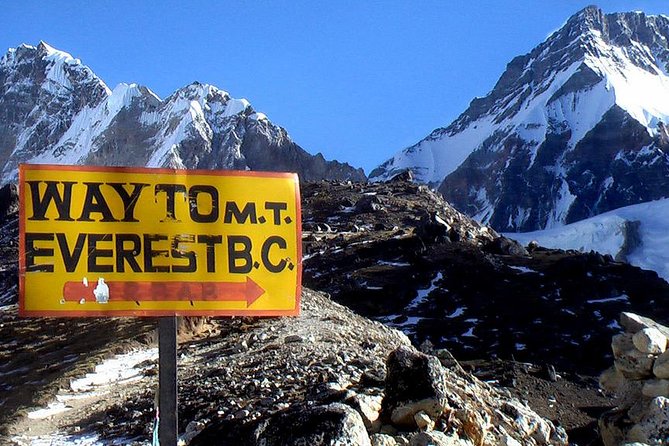
Nestled at an elevation of 3,867 meters, Tengboche offers trekkers a serene and culturally significant stop along the Everest Base Camp trek route. One of the highlights of this stop is the visit to the Tengboche Monastery, the largest monastery in the Khumbu region. This centuries-old monastery holds great religious importance for the Sherpa people and provides a glimpse into their spiritual practices. The monastery’s intricate architecture and colorful prayer flags add to the mystical atmosphere of the place. Visitors can witness the monks chanting prayers and experience a sense of tranquility amidst the backdrop of the majestic Himalayas. A visit to Tengboche is not just a trekking stop but a profound cultural experience that enriches the journey to Everest Base Camp.
| Tengboche Highlights | |
|---|---|
| Tengboche Monastery | Religious Significance |
| Colorful Prayer Flags | Cultural Immersion |
| Monk Chanting | Spiritual Atmosphere |
Dingboche (4,360m)

Situated at an altitude of 4,360 meters, Dingboche offers trekkers a strategic acclimatization point with stunning views of the surrounding Himalayan peaks.
Three key points about Dingboche:
-
Altitude sickness risk increases at this height, making it crucial for trekkers to acclimatize properly by staying hydrated and pacing themselves.
-
The village provides breathtaking mountain views, including Ama Dablam and Lhotse, offering trekkers a glimpse of the majestic Himalayan scenery.
-
Dingboche serves as a vital stopover for Everest Base Camp trekkers, allowing them to adjust to the altitude while enjoying the beauty of the Himalayan landscape.
Rest Day in Dingboche
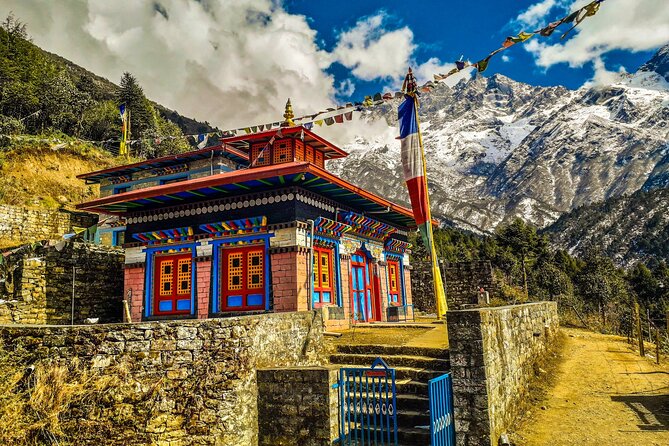
On the rest day in Dingboche, trekkers can explore the village’s picturesque surroundings and take in the panoramic views of the Himalayan peaks. This day serves as a crucial period for acclimatization benefits, allowing trekkers to adjust to the increasing altitude.
The village offers an excellent opportunity for local culture exploration, with its traditional stone houses and prayer flags fluttering in the mountain breeze. Visitors can interact with the friendly locals, visit the small monasteries, and gain insights into the Sherpa way of life.
Taking leisurely walks around Dingboche, admiring the stunning mountain vistas, and immersing in the peaceful ambiance can be both refreshing and enriching for trekkers before continuing their journey towards Everest Base Camp.
Lobuche (4,940m)
As trekkers ascend towards Lobuche at an altitude of 4,940m, they’re greeted by the rugged beauty of the high Himalayas and the stark terrain that characterizes this remote mountainous region. The journey to Lobuche offers trekkers a unique experience filled with challenges and rewards. Here are a few key aspects of Lobuche:
-
High Altitude: At 4,940m, trekkers will feel the effects of high altitude, requiring them to acclimatize properly to avoid altitude sickness.
-
Mountain Views: The panoramic vistas of the surrounding mountains, including Ama Dablam and Tawache, provide a breathtaking backdrop as trekkers make their way to Lobuche.
-
Remote Wilderness: Lobuche’s remote location immerses trekkers in the untouched beauty of the Himalayas, offering a true escape from the hustle and bustle of everyday life.
Gorakshep (5,164m)
Ascending further into the rugged terrain of the Himalayas, trekkers reach Gorakshep at an elevation of 5,164m, offering a challenging yet rewarding experience in the journey towards Everest Base Camp. At such a high altitude, acclimatization challenges become more pronounced, necessitating a slow and steady pace to prevent altitude sickness. Trekkers are advised to stay hydrated, maintain a proper diet, and listen to their bodies. The thin air at this elevation can make breathing more laborious, requiring increased effort during physical exertion. Despite the difficulties posed by the high altitude, the stunning views and sense of accomplishment make Gorakshep a memorable stop on the trek.
| High Altitude | Acclimatization Challenges |
|---|---|
| 5,164m | Intensified symptoms of altitude sickness |
Kala Patthar & Everest Base Camp
Standing at the majestic viewpoint of Kala Patthar, trekkers are greeted with breathtaking panoramic vistas of the iconic Everest Base Camp, a culmination of their arduous journey through the Himalayas. The experience offers:
-
Mountain Views: The unparalleled sight of Mount Everest and the surrounding peaks is awe-inspiring, providing trekkers with a sense of accomplishment.
-
Altitude Challenges: At an elevation of 5,400m, reaching Everest Base Camp presents significant altitude challenges, requiring physical endurance and acclimatization.
-
Photography Opportunities: The play of light and shadow on the Himalayan giants from Kala Patthar creates mesmerizing photo opportunities, capturing the beauty of the world’s highest peak and its surroundings.
Return to Namche
After marveling at the panoramic views from Kala Patthar and the iconic Everest Base Camp, trekkers begin their journey back to Namche, retracing the challenging yet rewarding path through the Himalayas. The return trip allows for gradual descent, aiding in altitude acclimatization.
Trekkers are advised to continue using acclimatization techniques such as staying hydrated, maintaining a steady pace, and taking rest breaks. Altitude sickness management remains crucial, with symptoms like headaches and fatigue requiring attention.
Descending from the high altitudes of Everest Base Camp and Kala Patthar towards Namche helps alleviate the stress on the body caused by reduced oxygen levels. The stunning landscapes provide a different perspective on the return journey, offering trekkers a chance to reflect on their accomplishment while prioritizing their health.
Back to Lukla
Upon completing the return journey from Namche, trekkers embark on the final leg of their adventure back to Lukla, where they originally began their trek to Everest Base Camp.
-
Mountain views: The trek back to Lukla offers stunning panoramic views of the Himalayas, allowing trekkers to marvel at the majestic peaks one last time.
-
Local culture: Along the trail, trekkers can continue to enjoy the rich local Sherpa culture, interacting with locals and experiencing their traditional way of life.
-
Memories: As they make their way back, trekkers reflect on the incredible journey they’ve undertaken, filled with challenging hikes, breathtaking landscapes, and unforgettable moments shared with fellow adventurers.
Departure From Kathmandu
Passengers eagerly gather at Kathmandu’s bustling airport, filled with anticipation for their upcoming journey to the breathtaking Everest Base Camp. Excitement fills the air as they prepare to embark on a once-in-a-lifetime adventure filled with stunning mountain views and rich cultural experiences.
The bustling airport serves as the starting point for this epic trek, with travelers checking in for their domestic flight to Lukla. As they board the plane, the anticipation builds, knowing that they’re about to witness some of the most awe-inspiring sights the Himalayas have to offer.
The short flight offers a preview of the majestic landscapes awaiting them, setting the stage for the incredible journey that lies ahead.
Last Words
Embark on the Everest Base Camp Trek in 14 Days for an unforgettable journey through the Himalayas. From the bustling streets of Kathmandu to the serene beauty of Namche Bazaar, this adventure offers a perfect blend of culture and nature.
With experienced guides leading the way, trekkers can conquer Kala Patthar and stand in awe at the iconic Everest Base Camp.
Make memories to last a lifetime on this epic expedition to the rooftop of the world.